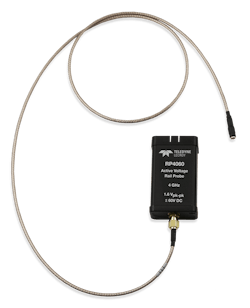Power electronics rail probes for test and measurement of low-voltage DC power introduced by Teledyne LeCroy
CHESTNUT RIDGE, N.Y. – Teledyne LeCroy in Chestnut Ridge, N.Y., is introducing the 2 GHz RP2060 and 4 GHz RP4060 power rail probes to enable engineers to probe a low-impedance, low-voltage DC power/voltage rail signal without loading the device under test (DUT).
The power electronics rail probes provide plus-or-minus 30 volts of probe offset to display a DC power/voltage rail signal in the vertical center of the oscilloscope regardless of the gain setting.
These test and measurement probes feature plus-or-minus 60-volt offset capability; plus-or-minus 800-millivolt dynamic range; 50 kilo-ohms DC input impedance for low loading of low-impedance power rails); 1.2:1 attenuation for low additive noise; MCX-terminated cable with a variety of board connections: 4 GHz-rated MCX PCB mount; 4 GHz solder-in; 3 GHz coaxial cable to U.FL PCB mount; and optional 500 MHz browser.
Bandwidths listed are for the 4 GHz RP4060. Maximum bandwidth when used with RP2060 is 2 GHz.
One driver is the increase in the number and size of data centers needed to support cloud computing and other data-intensive applications, and the new power architectures they require. The new rail probe is designed to meet the needs of engineers working with power rails rated to 48 volts DC.
To power individual servers in the racks that make up data centers, traditional server farms would step down power to the 12 volts DC necessary to input to the server, where within the server it would be further stepped down to the 5 volts, 3 volts, 1 volt or less to power the many individual chips.
This process loses much energy to heat, which in turn requires more energy to cool, raising costs. The average data center today uses an average of 3 to 5 kilowatts of electricity per rack.
New more efficient architectures use a 48 volts DC distribution voltage right at the server, where new types of power modules and digital controllers step it down to the much smaller voltages needed by other subsystems.
Related: Military test and measurement tools show flexibility
Engineers designing such systems need to probe DC voltages anywhere from 1 volt or less to 48 volts. Also, because it is a DC voltage, high-resolution oscilloscopes and probes with very high voltage offset are necessary to see the small amounts of ripple and other types of noise that may be present.
By increasing the 30-volt offset of the legacy RP4030 power rail probe to a comfortable 60 volts, the RP2060 and RP4060 power rail probes provide the voltage range and offset and sensitivity needed for the 48-volt power structure.
The input is through a high-bandwidth SMA connector, terminated to ground with a 50 kilo-ohm resistor in parallel with a 0.1-microfarad capacitor. This provides high input impedance near DC and low input impedance at high frequencies?highly desirable for low-impedance DC power rail probing.
Related: All- plastic ice sensor for UAVs
A two-stage offset D/A converter provides plus-or-minus 60-volt range. This permits the offset value to be set with accuracy of 0.1 percent at plus-or-minus 3-millivolts.
The output is through a BNC connection to the Teledyne LeCroy ProBus interface into a 50-Ohm oscilloscope termination. An auto zero grounding switch permits auto zero of the DC value at any time without disconnecting the probe from the device under test.
For more information contact Teledyne LeCroy online at https://teledynelecroy.com.
